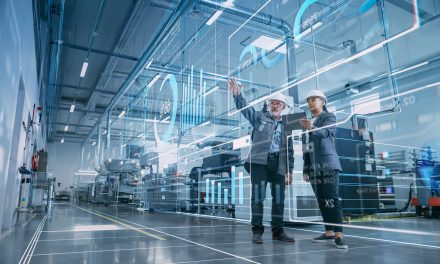A global shift to Industry 4.0 as the next phase in the digitisation of the manufacturing sector:
- IDC research shows that manufacturers worldwide are rapidly embracing new technologies to transform their business models and operations: 55 per cent of manufacturing organisations are underway with their digital transformation efforts according to a 2018 IDC Vertical Insights survey
- The same research revealed that just 23 per cent currently see digital transformation as a risk to their manufacturing organisation
Yet the rapidly expanding threat landscape combined with increasing digitisation across the manufacturing industry creates more potential attack vectors:
A recent report from McAfee – Grand Theft Data II – The Drivers and Shifting State of Data Breaches – revealed that IT security professionals across all sectors, including manufacturing, are still struggling to fully secure their organisation and protect against breaches, with 61 per cent claiming to have experienced a data breach at their current employer. Data breaches are getting more serious and are under greater scrutiny – nearly three-quarters of all breaches have required public disclosure or have affected financial results. One major issue highlighted in the report is that security technology continues to operate in isolation, with 81 per cent reporting separate policies or management consoles for cloud access security broker (CASB) and data loss prevention (DLP), resulting in delayed detection and remediation actions.
Insights from Mo Cashman, Principle Engineer at McAfee
So what are the key cybersecurity threats facing the manufacturing sector today?
“One of the biggest risks facing manufacturers today is the potential disruption of production services as a result of a cyber attack. The impact is immediately tangible and the cost of downtime is easily calculated in terms of lost business and reputation. Unfortunately, as manufacturers grapple with digital transformation, cybercriminals are also innovating to find new, more sophisticated methods to attack the sector.
“Information technology (IT) and operational technology (OT) convergence is increasing the cyber risk. Digital transformation projects are connecting historically isolated production systems with enterprise IT infrastructure to generate a huge range of benefits for the organisation, from greater insights through data analysis and maintaining a competitive edge to ensuring profitable productivity levels. Yet this shift often opens up potential vulnerabilities, creating conduits for malware to enter the organisation through end user workplace devices. Technology can transform businesses and generate cost savings, but we cannot ignore the potential risks. Ransomware and other forms of malware are often delivered through spear-phishing, have the capability to spread unattended and increasingly have a destructive payload. The combination of these threats with a lack of OT network segmentation and poor system hardening leads to a serious risk of production system downtime if not mitigated.”
Are manufacturers more vulnerable or more secure as they transition to becoming a ‘factory of the future’?
“Manufacturing organisations are transforming, whether through IT-OT convergence, the adoption of Industrial IoT technologies or shifting workloads to the cloud. With new systems come new attack surfaces and vectors – all of which should lead to new risk management considerations. Those operating in the manufacturing sector must recognise that cybercriminals are targeting the industry for valuable intellectual property and trade secrets as well as the traditional financial rewards. Business must be conscious of this risk and take the appropriate measures for cyber resilience.”
“Shifting to the cloud drives greater flexibility and innovation for manufacturers. Furthermore, when managed correctly, it offers greater visibility and therefore security. The first step is knowing where and how data is being used, shared and stored in the cloud by employees and partners. A true ‘factory of the future’ could not exist without the cloud. With the right policies and safeguards in place, manufacturers can protect data from device to cloud, detect malicious activity and correct any threats as soon as they arise – ensuring secure ‘factory of the future’ systems.”
So how can manufacturers undergoing a digital transformation process keep their data and systems secure?
“The first step is designing for resilience. This starts with using a cyber risk framework, such as NIST, to guide the security architecture development for production systems and measure maturity improvement overtime. The NIS-Directive also sets out a number of cyber security principles and several countries, including the UK, have produced practical guidance on how to implement those principles to boost the overall level of security for network and information systems.
“Secondly, cloud security is paramount to enabling transformation. The factory of the future depends on cloud-based applications to deliver the analytics and business insights necessary to reap the benefits of digital transformation. Securing the infrastructure in public cloud environments and ensuring data security controls for cloud-based Software-as-a-service (SaaS) services is key to success.
“Finally, take a ‘one enterprise’ approach to security and risk management. Many organisations still operate in silo. For instance, a CISO may be responsible for IT only, yet not charged with securing OT environments. This needs to change. Recent attacks demonstrate that threats to manufacturing systems enter from multiple routes. As a result, increased collaboration and achieving one unified view across the digital workplace, cloud services, industrial controls and the supply chain are necessary considerations if an organisation is to maintain business resilience as it transitions to create a factory of the future.”



